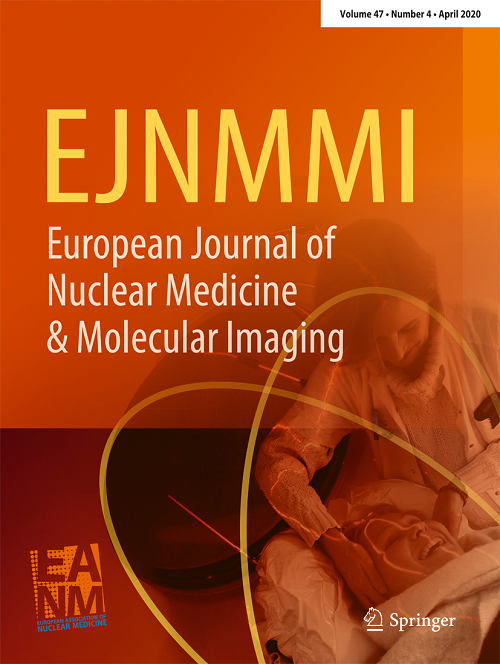[18F]FDG-PET显示帕金森病丘脑下核深部脑刺激术后早期皮层功能障碍。
IF 7.6
1区 医学
Q1 RADIOLOGY, NUCLEAR MEDICINE & MEDICAL IMAGING
European Journal of Nuclear Medicine and Molecular Imaging
Pub Date : 2025-10-02
DOI:10.1007/s00259-025-07552-0
引用次数: 0
摘要
目的:在帕金森病(PD)患者植入丘脑下核深部脑刺激(STN-DBS)电极后,可能立即出现运动改善和神经精神症状。我们使用脑[18F]氟脱氧葡萄糖正电子发射断层扫描([18F]FDG-PET)研究了刺激前电极植入对一过性功能障碍的影响。此外,我们试图确定与神经精神副作用(SE)相关的临床和影像学变量。方法回顾性分析13例晚期PD患者,术前和STN-DBS手术后3周内(中位6天)接受FDG-PET扫描。我们以体素的方式和兴趣量分析了区域代谢的变化。此外,我们评估了代谢减少的程度和幅度以及电极轨迹。神经精神SE被定义为临床记录中列出的新的、与手术相关的神经精神症状。结果pet分析显示,沿电极的低代谢(平均幅度高达-35.9±18.0%,平均范围为19.9±10.2 ml /半球)主要位于额叶(左:kE = 1718体素,右:kE = 1550体素,p < 0.05,错误发现率纠正)。神经精神性SE患者年龄较大(61岁比55岁,p = 0.043),术前额叶中回(MFG) FDG摄取正常化[18F]较低(1.01比1.06,p = 0.030)。术前MFG代谢和年龄指示神经精神SE的发生(受试者工作特征曲线下面积= 0.90)。结论[18F]FDG-PET可检测STN-DBS术后可逆性神经元功能障碍。术前MFG代谢和年龄与术后神经精神SE相关,支持使用PET改善患者选择和术后护理理念。本文章由计算机程序翻译,如有差异,请以英文原文为准。
[18F]FDG-PET reveals early postoperative cortical dysfunction after subthalamic nucleus deep brain stimulation in Parkinson's disease.
PURPOSE
Motor improvement and neuropsychiatric symptoms may immediately follow implantation of subthalamic nucleus deep brain stimulation (STN-DBS) electrodes in Parkinson's disease (PD). We investigated the impact of electrode implantation prior to stimulation on transient dysfunction using cerebral [18F]fluorodeoxyglucose positron emission tomography ([18F]FDG-PET). Additionally, we sought to identify clinical and imaging variables associated with neuropsychiatric side effects (SE).
METHODS
This retrospective analysis included thirteen patients with advanced PD, receiving [18F]FDG-PET scans preoperatively and within three weeks (median 6 days) after STN-DBS surgery. We analyzed changes of regional metabolism in a voxel-wise manner and with volumes-of-interests. Moreover, we evaluated the extent and magnitude of metabolic decrease alongside the electrode trajectories. Neuropsychiatric SE were defined as novel, surgery-related neuropsychiatric symptoms listed in clinical records.
RESULTS
PET analyses revealed hypometabolism along the electrodes (mean magnitude up to -35.9 ± 18.0% and mean extent of 19.9 ± 10.2 ml per hemisphere) largely located in the frontal lobe (left: kE = 1718 voxels; right: kE = 1550 voxels, p < 0.05, false discovery rate corrected). Patients with neuropsychiatric SE were older (61 vs. 55 years; p = 0.043) and had lower normalized [18F]FDG uptake in the middle frontal gyrus (MFG) preoperatively (1.01 vs. 1.06; p = 0.030). Preoperative metabolism in the MFG and age were indicative of the occurrence of neuropsychiatric SE (area under the Receiver Operating Characteristic curve = 0.90).
CONCLUSIONS
Reversible neuronal dysfunction after STN-DBS surgery can be detected by [18F]FDG-PET along the electrode trajectory. Preoperative MFG metabolism and age were associated with postoperative neuropsychiatric SE supporting the use of PET to improve patient selection and postoperative care concepts.
求助全文
通过发布文献求助,成功后即可免费获取论文全文。
去求助
来源期刊
CiteScore
15.60
自引率
9.90%
发文量
392
审稿时长
3 months
期刊介绍:
The European Journal of Nuclear Medicine and Molecular Imaging serves as a platform for the exchange of clinical and scientific information within nuclear medicine and related professions. It welcomes international submissions from professionals involved in the functional, metabolic, and molecular investigation of diseases. The journal's coverage spans physics, dosimetry, radiation biology, radiochemistry, and pharmacy, providing high-quality peer review by experts in the field. Known for highly cited and downloaded articles, it ensures global visibility for research work and is part of the EJNMMI journal family.

 求助内容:
求助内容: 应助结果提醒方式:
应助结果提醒方式:


